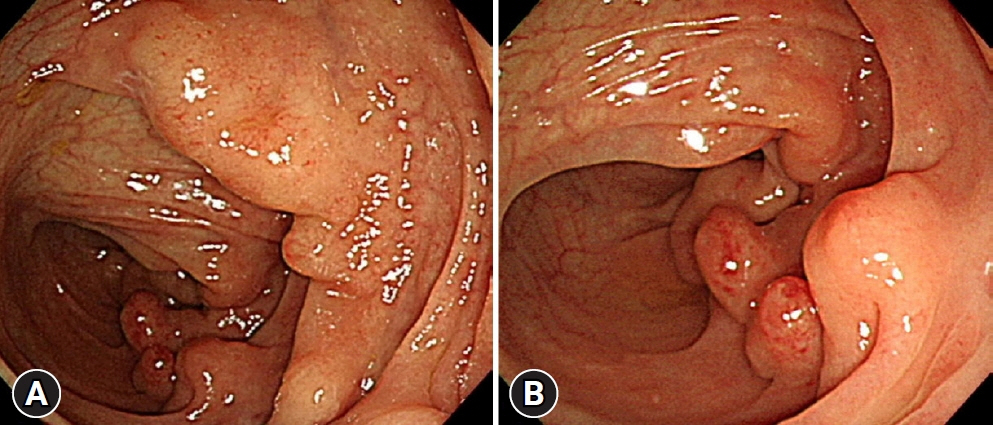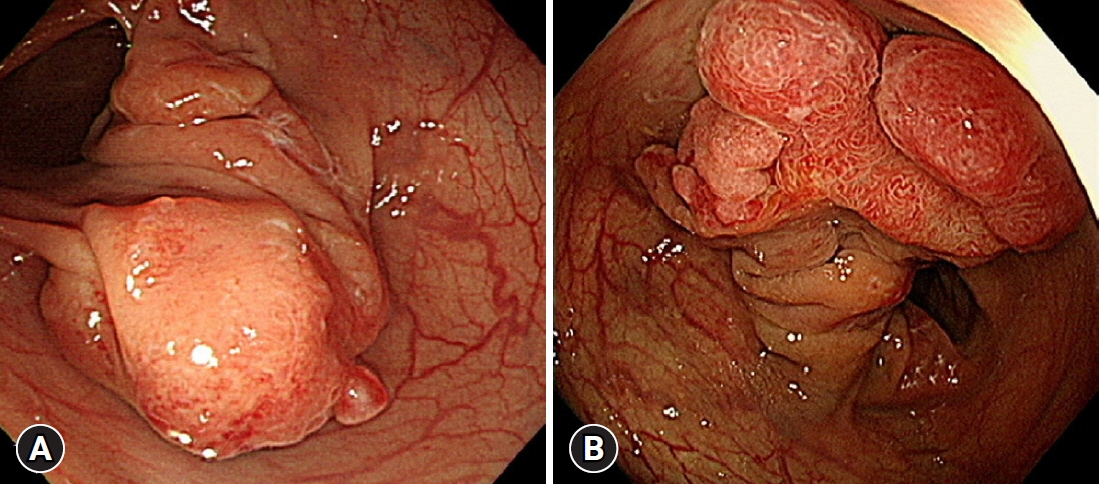Clin Endosc.
2022 May;55(3):452-457. 10.5946/ce.2021.013.
Development of colon cancer in a patient with longstanding colonic diffuse ganglioneuromatosis: a case report
- Affiliations
-
- 1Department of Internal Medicine, Hoengseong Daeseong Hospital, Hoengseong, Korea
- 2Department of Gastroenterology, Asan Medical Center, University of Ulsan College of Medicine, Seoul, Korea
- 3Department of Pathology, Asan Medical Center, University of Ulsan College of Medicine, Seoul, Korea
- KMID: 2529969
- DOI: http://doi.org/10.5946/ce.2021.013
Abstract
- Colonic diffuse ganglioneuromatosis is an extremely rare disease in which multiple tumors derived from the ganglion cells, nerve fibers, and supporting cells are distributed in the colon. It is generally considered to be a benign neoplastic condition and is occasionally associated with rare hereditary conditions such as neurofibromatosis type I or multiple endocrine neoplasia type 2B. Here, we report a case of a patient in whom colon cancer developed 12 years after the initial diagnosis of colonic diffuse ganglioneuromatosis, which suggests a possible association between colonic diffuse ganglioneuromatosis and colorectal cancer.
Figure
Reference
-
1. Jass JR, Sobin LH, Watanabe H. The World Health Organization’s histologic classification of gastrointestinal tumors: a commentary on the second edition. Cancer. 1990; 66:2162–2167.2. Dellinger GW, Lynch CA, Mihas AA. Colonic ganglioneuroma presenting as filiform polyposis. J Clin Gastroenterol. 1996; 22:66–70.3. Rafiq S, Hameer H, Sitrin MD. Ganglioneuromatous polyposis associated with juvenile polyps and a tubular adenoma. Dig Dis Sci. 2005; 50:506–508.4. Shekitka KM, Sobin LH. Ganglioneuromas of the gastrointestinal tract: relation to Von Recklinghausen disease and other multiple tumor syndromes. Am J Surg Pathol. 1994; 18:250–257.5. d’Amore ES, Manivel JC, Pettinato G, et al. Intestinal ganglioneuromatosis: mucosal and transmural types: a clinicopathologic and immunohistochemical study of six cases. Hum Pathol. 1991; 22:276–286.6. Ferro de Beça F, Lopes J, Maçoas F, et al. Tactoid body features in a Schwann cell hamartoma of colonic mucosa. Int J Surg Pathol. 2014; 22:438–441.7. Abdelfatah M, Sangah G, Harvin G. What do we need to know about colonic polypoid ganglioneuroma? A case report and a comprehensive review. J Gastrointest Cancer. 2018; 49:327–332.8. Snover DC, Weigent CE, Sumner HW. Diffuse mucosal ganglioneuromatosis of the colon associated with adenocarcinoma. Am J Clin Pathol. 1981; 75:225–229.9. Tomita H, Miya K, Tanaka H, et al. Ganglioneuroma and adenocarcinoma associated with neurofibromatosis type 1 in the colorectal region. Int J Colorectal Dis. 2006; 21:89–91.10. Trufant JW, Greene L, Cook DL, et al. Colonic ganglioneuromatous polyposis and metastatic adenocarcinoma in the setting of Cowden syndrome: a case report and literature review. Hum Pathol. 2012; 43:601–604.11. Kanter AS, Hyman NH, Li SC. Ganglioneuromatous polyposis: a premalignant condition. Report of a case and review of the literature. Dis Colon Rectum. 2001; 44:591–593.
- Full Text Links
- Actions
-
Cited
- CITED
-
- Close
- Share
- Similar articles
-
- Bowel Perforation in a Patient with Pheochromocytoma, Multiple Endocrine Neoplasia Type 2B and Diffuse Intestinal Ganglioneuromatosis: A Case Report
- Diffuse Ganglioneuromatosis of the Colon Presenting as a Large Subepithelial Tumor in Adults: Report of Two Cases
- Polypoid Ganglioneuromatosis of Colon: A case report
- Diffuse Ganglioneuromatosis of Appendix associated with Von Recklinghausen;s Disease
- A Case of Ganglioneuromatosis of the Colon





